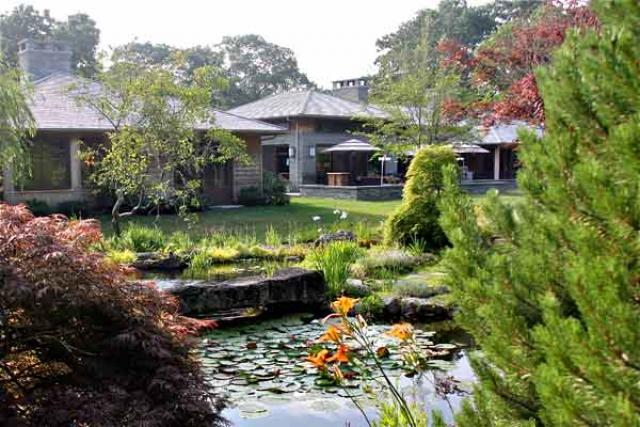Quintessential Compound

Monica Graham has always been fascinated by the idea of a Gertrude Stein salon, to which visitors were drawn by master works of art. In her own way, she has put together a compound with masterly gardens and indoor amenities to which her many relatives and friends are drawn. There are actually three gardens – a multi-level water garden with a rivulet, koi ponds, and small waterfalls, a formal, enclosed garden with a fountain, and a woodland garden. On the South Fork, where many second homes are enhanced by outstanding gardens, hers are considered spectacular and are in demand for charitable tours. But the buildings in the compound are extraordinary, too. One house, original to the property and near the street, was gutted and expanded. It is now a jewel of a guest house that provides long views of the grounds. A small two-story barn with a fireplace doubles as a screening room, and there also is a greenhouse nearby. Every room in the main house has a garden view, while the basement has an indoor swimming pool and a gym. If a tennis court is missing, it may be because Ms. Graham, a former hedge fund manager, and her brother, John Graham, own Hampton Racquet, an East Hampton tennis facility. Ms. Graham bought two houses on adjacent lots off a quiet East Hampton Village street in 2009, The main house sits on the footprint of the other house original to the property, which she called “teensy” and described as a throwback to the ’60s ond ’70s. Its dominant color was mauve (Formica counters, shag rug), and the master bedroom had a hot tub and mirrored ceilings. “I tried to give it to the Fire Department,” she said, thinking the volunteers would set it afire as an exercise. Habitat for Humanity was not interested in any of the materials. But the Police Department said yes, and used it for a SWAT drill. “They came and shot the place up and threw gas in the windows,” she said. It resembled a war zone. The main house, which she planned for herself and for entertaining, is a long, low, one-story shout out to Frank Lloyd Wright with roofs that overhang and clerestory windows but it is also filled with details that take their cue from traditional Japanese architecture. An outdoor patio, with red couches and a fireplace, is shielded by umbrellas that replicate the rooflines. The living room, dining room, and large kitchen, with its own sitting area and a long farm table, and a large, screened-in porch are separated from the bedroom wing by a long hall. The master suite has a separate sitting room and Ms. Graham’s study, and there are two rooms for guests. The gym is equipped with first-class equipment and flat-screen TVs, and the pool has a pair of underwater treadmills. Ms. Graham said she interviewed 14 architects before settling on Christian Ricci. He had been recommended by “the folks at Jed Johnson,” an interior design firm in the city, for which he had designed furniture and built-in cabinetry. Knowing he was not yet licensed as an architect, she said, “I liked him but I wasn’t sure.” However, she was won over by the “enthusiasm and passion” he demonstrated and by the deluge of drawings he sent her with exciting ideas. “Maybe I’m nuts, but I’m going to give him a shot,” she said to herself. “It’s the best decision I ever made.” Ms. Graham plied Mr. Ricci with books on Balinese art and architecture, but he was concerned that the style would be too tropical for East Hampton. He had a longstanding appreciation of Japanese carpentry designs, however, and was able to combine the traditions of both cultures. An interior designer, Robert Kirkland, was brought in. They all agreed that the solution was to create wooden screening throughout. The primary screen, from which all other woodworking elements emanate, is a free standing spindle-work panel that separates living room and dining room. “We tried to create a house that was crafted rather than put together with studs and Sheetrock,” Mr. Ricci said. The motif carries over into sliding pocket doors in the dining room and study, and even into details as small as vent grills. About the living room, Ms. Graham said, “I could have done floor to ceiling windows.” Instead, a screen-like grid makes the spaces in the large room “feel more intimate and homey.” Ms. Graham worked with a landscape architect, Elizabeth Curtin, in planning the gardens. But she became so involved herself that she attended the master gardener program at the Cornell Cooperative Extension in Riverhead. And the project wasn’t easy. Ms. Graham had been presented with a landscape plan she considered grandiose by a professional who wanted to pull out a grove of century-old oaks for the outdoor pool. She scrapped that idea after paying him a pretty penny, she said, and went with basic outlines that Mr. Kirkland, the interior designer, sketched on a piece of paper in an hour. Then there was bamboo to cope with — forests of it. “We had to dig down four feet to remove all the rhizomes,” she said. “We took 48 truckloads of dirt out.” Despite all that effort, bamboo shoots still encroach. Ms. Graham, the sixth of seven children, grew up in Flushing, Queens, in a small house where the backyard was paved. A picnic table was its single feature. In East Hampton, she has not only compensated for what she said was a horticulturally deprived childhood, but created an incomparable oasis.
